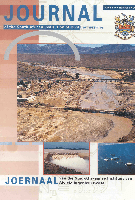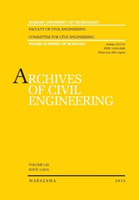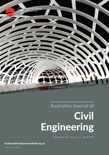
Journal of the South African Institution of Civil Engineering
Scope & Guideline
Exploring sustainable solutions for modern challenges.
Introduction
Aims and Scopes
- Structural Engineering and Material Performance:
The journal publishes research on structural integrity, performance assessment, and innovative construction materials, emphasizing studies on concrete, steel, and composite materials under various loading conditions. - Transportation Engineering and Safety:
Research on transportation infrastructure, including road safety assessments, traffic management, and sustainable mobility solutions, is a significant focus area, aiming to improve the safety and efficiency of transportation systems. - Water Resources and Environmental Engineering:
The journal explores topics related to water quality modeling, flood risk assessment, and sustainable water management strategies, highlighting the importance of environmental considerations in engineering practices. - Geotechnical Engineering and Soil Mechanics:
Papers addressing soil behavior, geotechnical investigations, and the impact of geological conditions on construction practices are prevalent, reflecting the need for robust foundations and earthworks in civil engineering. - Climate Resilience and Sustainability:
The journal emphasizes research on the impacts of climate change on infrastructure, promoting sustainable design practices and resilience strategies to mitigate environmental risks in construction.
Trending and Emerging
- Resilience and Adaptation to Climate Change:
Research on infrastructure resilience to climate change impacts is on the rise, emphasizing the need for engineering solutions that can withstand extreme weather events and changing environmental conditions. - Advanced Computational Modelling Techniques:
There is an increasing trend in the use of advanced numerical modeling and simulation techniques to predict structural behavior and optimize design processes, reflecting a move towards data-driven engineering practices. - Sustainable and Innovative Construction Practices:
Emerging themes include the exploration of sustainable materials and construction methods, such as recycled materials and low-impact designs, as the industry seeks to reduce its environmental footprint. - Smart Infrastructure and Technology Integration:
The integration of technology in civil engineering, including the use of big data, BIM, and IoT, is gaining attention as researchers explore how these innovations can enhance infrastructure management and efficiency. - Comprehensive Risk Assessment Frameworks:
There is a growing emphasis on holistic risk assessment frameworks that consider a range of factors, including environmental, social, and economic impacts, in the planning and execution of civil engineering projects.
Declining or Waning
- Traditional Materials Research:
There has been a noticeable decline in research focused solely on conventional materials, such as basic concrete or standard asphalt mixes, as the field shifts towards more innovative and sustainable material solutions. - Generalized Safety Assessments:
Broad approaches to safety assessment without specific contextual applications are becoming less frequent. The trend is moving towards more detailed, context-specific safety evaluations that consider unique local conditions. - Conventional Water Management Techniques:
Research centered around traditional water management strategies is waning, as newer, more integrated approaches that consider climate change impacts and sustainability are gaining traction.
Similar Journals

KSCE Journal of Civil Engineering
Transforming Ideas into Engineering ExcellenceKSCE Journal of Civil Engineering is a prestigious international publication dedicated to advancing the field of civil engineering. Established by the Korean Society of Civil Engineers (KSCE), this journal serves as a vital platform for high-quality research in the discipline, showcasing innovative methodologies, case studies, and critical analyses pertinent to civil and structural engineering. With an impact factor placing it in the Q2 category of civil engineering journals for 2023 and a solid Scopus rank of #141 out of 379, it reflects the significant contributions of its authors and the growing recognition of its published works. KSCE Journal of Civil Engineering, based in Germany and easily accessible to the global research community, is committed to disseminating knowledge with rigor and integrity, encouraging both emerging scholars and seasoned experts to contribute to the evolving discourse in civil engineering. With a convergence period from 2009 to 2024, the journal continues to uphold its mission of fostering innovation and excellence in engineering practice.

Archives of Civil Engineering
Elevating Standards in Civil Engineering ResearchArchives of Civil Engineering is a premier academic journal published by POLISH ACAD SCIENCES, dedicated to advancing the field of civil and structural engineering. Established in 1996, this open-access journal has been pivotal in disseminating high-quality research and innovation in engineering practices, particularly since adopting open access in 2010. With an ISSN of 1230-2945 and E-ISSN of 2300-3103, it enjoys a notable reputation, currently ranked in Q3 of the Civil and Structural Engineering category for 2023, reflecting its considerable contribution to scholarly content in the discipline. The journal caters to a diverse audience of researchers, professionals, and students, providing them with a platform to share and access essential findings. Its commitment to high academic standards is underscored by its ranking in Scopus, where it stands at Rank #265/379. Located in Warsaw, Poland, the journal aims to promote international collaboration and foster knowledge exchange in civil engineering, making it an indispensable resource for anyone involved in this dynamic field.

International Journal of GEOMATE
Bridging disciplines to enhance understanding in soil science and construction.The International Journal of GEOMATE, published by GEOMATE INT SOC based in Japan, is a pivotal resource for scholars and practitioners in the fields of Building and Construction, Environmental Engineering, Geotechnical Engineering, and Soil Science. Established in 2011 and continuing to set the standard in its focus areas, this journal serves as a platform for innovative research and practical applications, with contributions that significantly enhance the understanding and development of sustainable engineering practices. With its current classification in the Q3 quartile across multiple categories, it strives to disseminate critical knowledge and foster dialogue among a diverse audience, including researchers, industry professionals, and students. Though operating under a traditional subscription model, the journal's emphasis on rigorous peer review and high-quality publications ensures a substantial impact factor, further reinforcing its reputation in academia. Spanning from 2011 to 2024, the International Journal of GEOMATE invites contributions that advance the knowledge frontier and address contemporary challenges in engineering and environmental science.

Structure and Infrastructure Engineering
Exploring Innovations in Structure and InfrastructureStructure and Infrastructure Engineering, published by TAYLOR & FRANCIS LTD, is a premier academic journal that serves as a vital resource in the fields of engineering and construction. Featuring an ISSN of 1573-2479 and an E-ISSN of 1744-8980, this journal has established its reputation as a leader in disseminating high-quality research. Since its inception, it has successfully transitioned through converged years from 2007 to 2024, earning a prestigious position within the Q1 quartile across multiple engineering disciplines, including Building and Construction, Civil and Structural Engineering, and Ocean Engineering, among others. Its impact is underscored by impressive Scopus rankings, particularly its 5th rank in Ocean Engineering within the top 95th percentile. The journal’s commitment to advancing knowledge in safety, risk, reliability, and quality makes it an indispensable platform for researchers, professionals, and students aiming to stay at the forefront of engineering innovations. Access to its comprehensive articles allows for a deeper understanding of contemporary challenges and solutions in infrastructure development.

Turkish Journal of Civil Engineering
Pioneering Knowledge for Tomorrow's EngineersWelcome to the Turkish Journal of Civil Engineering, a pioneering publication under the auspices of the TURKISH CHAMBER OF CIVIL ENGINEERS, dedicated to advancing the field of civil engineering and construction. With a focus on cutting-edge research and innovative practices, this journal seeks to provide a platform for scholars, professionals, and students to share their findings and insights within the sphere of civil and structural engineering. The journal is committed to open access, ensuring that research is readily available to a global audience. As it embarks on its journey from 2023 to 2024, it aims to enhance its reputation as a vital resource within the academic community, currently ranking in the 40th percentile for Building and Construction Engineering and 32nd for Civil and Structural Engineering in Scopus. We encourage contributions that push the boundaries of engineering knowledge, fostering collaboration and progress in this essential field.

Australian Journal of Civil Engineering
Fostering Innovation in Civil and Structural PracticesThe Australian Journal of Civil Engineering, published by Taylor & Francis Ltd, stands as a pivotal platform within the field of civil and structural engineering. With an ISSN of 1448-8353 and an E-ISSN of 2204-2245, this journal consistently delivers high-quality research and innovative practices from both established and emerging scholars in the discipline. Recognized in the Q2 category for Civil and Structural Engineering in 2023, it holds a respectable position, ranking 146 out of 379 within its field according to Scopus, which places it in the 61st percentile. Converging valuable insights from 2011 through 2024, the journal encompasses a broad scope of topics, including sustainable infrastructure, innovative materials, and advanced construction techniques, thereby addressing contemporary challenges faced by engineering professionals. Though it is a traditional publication without open access options, the quality of the research featured ensures that it remains an essential resource for academics, practitioners, and students striving to enhance their knowledge and contribute to the dynamic field of civil engineering.

Baltic Journal of Road and Bridge Engineering
Transforming Challenges into Engineering TriumphsThe Baltic Journal of Road and Bridge Engineering, published by RIGA TECHNICAL UNIV-RTU, serves as a pivotal platform for disseminating cutting-edge research in the fields of building and construction as well as civil and structural engineering. Established as an Open Access journal since 2006, it fosters global collaboration and accessibility to critical engineering knowledge, facilitating the exchange of innovative ideas among researchers, professionals, and students. With a commendable impact factor and recognition in Scopus rankings, where it stands in the third quartile for both relevant engineering categories, the journal underscores its significance in advancing the discipline. The journal aims to publish high-quality, peer-reviewed articles that address contemporary challenges in road and bridge engineering, making it an essential resource for anyone involved in infrastructure development and research. Located in Lithuania at 6B Kipsalas Street, RIGA LV-1658, this journal not only highlights the latest advancements but also seeks to inspire future innovations in engineering practices.

CANADIAN JOURNAL OF CIVIL ENGINEERING
Advancing Civil Engineering Knowledge Since 1971Canadian Journal of Civil Engineering, published by Canadian Science Publishing, serves as a premier platform for the dissemination of innovative research and development in the fields of civil and structural engineering, as well as environmental science. Established in 1971, this journal maintains a robust reputation, achieving a Q3 ranking in both civil engineering and general environmental science categories as of 2023. While it does not currently offer open access, the journal is accessible to a wide audience of researchers, professionals, and students who are keen to stay abreast of the latest advancements in civil engineering practices. With a significant number of yearly publications and a committed editorial board, the Canadian Journal of Civil Engineering contributes to the foundational knowledge and practical applications in the engineering community, thereby playing a critical role in addressing contemporary challenges in civil infrastructure and environmental sustainability.

Teknik Dergi
Navigating the Evolving Landscape of EngineeringTeknik Dergi is a key academic journal published by the Turkish Chamber of Civil Engineers, focusing on the critical fields of Building and Construction as well as Civil and Structural Engineering. Established in Turkey, this journal serves as a vital platform for researchers, practitioners, and students to disseminate innovative findings and advancements within these disciplines. Although its coverage in databases like Scopus has been discontinued since 2022, Teknik Dergi remains a respected resource for its historical contributions, with a record of publication spanning from 1990 to 1998 and then from 2002 to 2022. The journal currently holds a Q4 categorization in both its primary fields, ranking within the 30th and 25th percentiles respectively. Authors and readers can access articles exploring practical applications and theoretical foundations, making it a valuable asset for those engaged in the rapidly evolving landscape of civil engineering. Open Access options are also available, allowing for broader dissemination and engagement with its published work.

Periodica Polytechnica-Civil Engineering
Advancing Civil Engineering for a Sustainable FuturePeriodica Polytechnica-Civil Engineering is a prestigious journal published by the Budapest University of Technology and Economics, dedicated to advancing the field of civil engineering through high-quality research and innovative practices. Established in 1972, the journal has transitioned through various phases of publication and now spans an expansive range of topics within civil and structural engineering, geotechnical engineering, and engineering geology. With an impact factor indicating its growing influence and a commendable placement in the Q3 quartile according to the latest 2023 metrics, it recognizes contributions that bridge theoretical advancements with practical applications. While currently not open access, the journal remains a vital resource for researchers, professionals, and students seeking to stay abreast of the latest developments in engineering design, construction techniques, and geotechnical innovations. The continuous publication of significant research after almost five decades underscores its commitment to disseminating knowledge crucial for the world’s infrastructure challenges, making it an essential reference point within the engineering community.